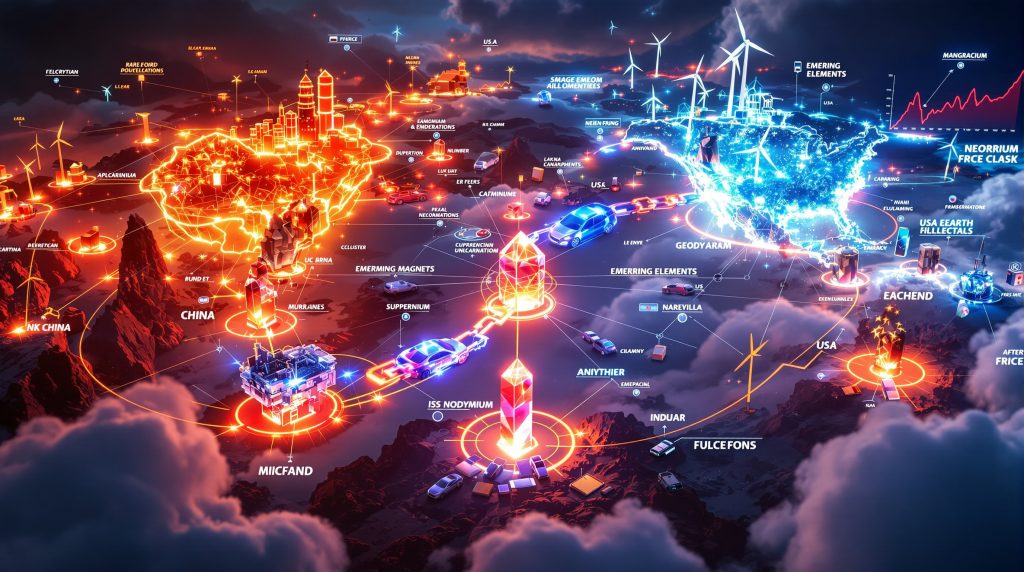What Are Rare Earth Elements and Why Are They Strategically Important?
Rare earth elements (REEs) comprise a unique group of 17 metallic elements on the periodic table—the 15 lanthanides plus scandium and yttrium. Despite their name suggesting scarcity, these elements are relatively abundant in the Earth's crust, but rarely occur in concentrated deposits that make extraction economically viable.
Their strategic importance stems from their irreplaceable properties in modern technology. These elements possess exceptional magnetic, luminescent, and electrochemical properties that make them crucial components in numerous high-tech applications that power our modern world.
Critical Components in Modern Technology
REEs serve as the backbone of countless technologies we rely on daily. Their unique electromagnetic properties enable the miniaturization of electronics while maintaining or improving performance—a critical factor in our increasingly digital world.
Neodymium, praseodymium, dysprosium, and terbium are particularly valuable for creating high-performance permanent magnets that are:
- 10-15 times stronger than traditional ferrite magnets
- Essential for electric vehicle motors and wind turbine generators
- Critical in defense systems including precision-guided missiles and radar equipment
- Foundational to miniaturized electronics in smartphones and computer hard drives
The U.S. Geological Survey emphasizes that these elements have become indispensable in green technology applications and defense systems, with demand growth consistently outpacing new supply development.
Strategic Value Beyond Industrial Applications
The military applications of REEs extend far beyond commercial uses, creating national security implications that transform these minerals into strategic assets:
- Missile guidance systems rely on rare earth magnets for precision control
- Night vision equipment requires rare earth phosphors
- Communication systems and radar technologies depend on rare earth components
- Aircraft engines and naval propulsion systems incorporate rare earth alloys
The clean energy transition places additional strategic pressure on rare earth supply chains. Wind turbines require approximately 600 kg of rare earth materials per megawatt of capacity, while electric vehicles may contain 1-4 kg of rare earth elements in their motors and electrical systems.
Nations that control these resources gain significant geopolitical leverage. This reality has transformed what was once considered merely an industrial commodity into a critical minerals energy security that influences international relations and national security planning.
How Did China Establish Dominance in the Rare Earth Market?
China's commanding position in the global rare earth market didn't happen by accident. It resulted from decades of strategic planning, government investment, and willingness to bear environmental costs that other nations avoided. This methodical approach transformed China from a minor player into the dominant force controlling approximately 60% of global mining and 85-90% of processing capacity, according to the U.S. Geological Survey.
Historical Development of China's REE Industry
China's journey to rare earth dominance began in the 1980s when the government identified these elements as strategically valuable. Under Deng Xiaoping's famous proclamation that "the Middle East has oil, China has rare earths," the country embarked on a comprehensive development strategy:
- Systematic government investment in mining operations, particularly in Inner Mongolia
- Acquisition and development of processing technologies
- Creation of research institutes focused specifically on rare earth applications
- Development of downstream manufacturing to capture value-added production
- Consolidation of previously fragmented mining operations under state guidance
By the early 2000s, China had established such overwhelming market dominance that mines in other countries, including the United States' Mountain Pass operation in California, couldn't compete and were forced to close.
Economic and Environmental Factors
China's dominance wasn't achieved through technological superiority alone. Several economic and environmental factors played crucial roles:
- Lower production costs through economies of scale and less stringent environmental controls
- Willingness to accept environmental degradation in key mining regions
- Development of advanced processing technologies through decades of focused research
- Integration of rare earth production with manufacturing sectors
- Ability to sustain below-cost pricing to eliminate international competition
The environmental impact of rare earth mining and processing in China has been severe. Regions like Baotou in Inner Mongolia have experienced significant environmental degradation, including contaminated groundwater and soil. These environmental costs were effectively externalized to gain market control—a tradeoff other nations were unwilling to make.
China's rare earth strategy demonstrates remarkable foresight—accepting short-term environmental costs and economic losses to secure long-term strategic advantage in critical materials that would become essential to future technologies.
What Triggered the Current Rare Earth Elements Trade War?
The current rare earth elements trade war represents the culmination of years of growing tension over supply chain vulnerabilities and technological competition between global powers. While these minerals have long been recognized as strategically important, recent actions have transformed simmering concerns into open economic conflict.
Escalation Timeline and Key Events
The current conflict escalated significantly when China implemented export restrictions on rare earth magnets and related materials. According to the transcript from Chairman's Briefing, "China restricted magnet exports around [April 2025] to the US, shutting down auto plants in the country."
This action represented a significant escalation from previous trade tensions. China's restrictions specifically targeted processed materials and finished magnets rather than raw materials, strategically focusing on higher-value products in the supply chain.
The U.S. response was swift and targeted. As noted in the transcript, Washington retaliated "by signing MP Materials to an exclusive deal, requiring the company to stop feeding Chinese factories and refined materials domestically instead." MP Materials, operating the only active rare earth mine in the United States, halted all raw material exports to China.
This exchange of restrictive measures created immediate disruptions in both countries:
- American auto plants faced shutdowns due to magnet shortages
- Chinese manufacturers encountered supply constraints during peak production season
- Global prices for critical rare earth elements surged to multi-year highs
- Supply chain uncertainties triggered stockpiling behaviors
Strategic Objectives Behind Export Controls
China's export restrictions serve multiple strategic objectives beyond simple trade retaliation:
- Creating leverage over U.S. manufacturing sectors, particularly automotive and renewable energy
- Responding to Western attempts to reduce dependence on Chinese supply chains
- Protecting domestic downstream industries and value-added manufacturing
- Demonstrating economic power in broader geopolitical negotiations
- Testing Western vulnerability to supply chain disruptions in critical materials
From the U.S. perspective, securing domestic supply through exclusive arrangements with MP Materials represents a clear attempt to rebuild critical mineral independence. This approach aligns with broader efforts to reduce vulnerability to foreign supply disruptions in strategically important materials.
The timing of these developments, as noted in the transcript, is particularly challenging: "They're [China] in peak manufacturing season for electric vehicles and wind turbines just as their supply tightens." This suggests that the trade restrictions are having their intended effect of creating economic pressure on both sides.
What Are the Immediate Economic Impacts of the REE Trade War?
The rare earth elements trade war has triggered significant economic repercussions throughout global supply chains, affecting industries from automotive to renewable energy. These impacts manifest most visibly in market pricing and manufacturing disruptions.
Price Surges and Market Volatility
The Chairman's Briefing transcript confirms that "prices of two rare earth elements needed for super strong magnets have surged to their highest in more than two years." This price spike directly resulted from supply uncertainties created when "American miner MP Materials stopped raw material exports to China."
Market dynamics show clear signs of supply-demand imbalance:
- Analysts cited in the transcript "expect demand to grow 10% this year while Chinese output increases only 5%"
- This widening gap between supply and demand drives price volatility
- Stockpiling behavior among manufacturers further amplifies price pressures
- Spot market prices have experienced greater volatility than long-term contract prices
For rare earth mining companies, this price environment creates a welcome change. The transcript notes that "rare earth producers are finally profitable again after years of selling below production costs." This profitability shift could accelerate investment in new production capacity, potentially addressing long-term supply constraints.
Manufacturing Disruptions
The manufacturing impacts of rare earth supply disruptions have been immediate and significant. As noted in the transcript, China's export restrictions led to "shutting down auto plants in the country [U.S.]."
These disruptions extend throughout industrial supply chains:
- Automotive production schedules face delays and uncertainties
- EV manufacturers particularly affected due to magnet-dependent motor designs
- Wind turbine installations potentially delayed as component availability becomes constrained
- Electronics manufacturers implementing allocation systems for critical components
The transcript also highlights a critical question facing manufacturers: "magnet makers now face the question of whether they can absorb these higher material expenses." This cost pressure creates difficult choices for downstream manufacturers:
- Absorb higher input costs, reducing profit margins
- Pass costs to consumers, potentially affecting demand
- Redesign products to reduce rare earth content
- Seek alternative suppliers outside restricted trade channels
For Chinese manufacturers, the timing creates particular challenges. The transcript notes they're "in peak manufacturing season for electric vehicles and wind turbines just as their supply tightens." This seasonal production pressure amplifies the economic impact of supply constraints.
How Are Western Nations Responding to Supply Chain Vulnerabilities?
Western nations, confronted with their vulnerability to rare earth supply disruptions, have initiated comprehensive strategies to reduce dependence on Chinese sources. These efforts combine government policy, financial incentives, and international partnerships aimed at creating resilient supply chains.
U.S. Strategic Initiatives
The United States has implemented a multi-faceted approach to addressing rare earth supply vulnerabilities:
- The Defense Production Act has been invoked for critical mineral supply chains, according to the Federal Register's "Critical Materials DPA Actions" (2024)
- Government funding for domestic supply chain development includes $3.16 billion allocated through the Inflation Reduction Act for battery supply chains, as reported by the Department of Energy (2024)
- Tax incentives encourage investment in domestic processing capabilities
- Strategic stockpile expansions now include critical rare earth materials
- Research funding targets both recycling technologies and alternative materials
The exclusive domestic supply agreement with MP Materials, mentioned in the Chairman's Briefing transcript, represents a concrete example of these policies in action. By redirecting material flow from export to domestic processing, the U.S. aims to rebuild complete supply chain capabilities within its borders.
In addition, the recent executive order on critical minerals further strengthens the U.S. position by prioritizing domestic production and processing capabilities for these vital resources.
International Alliances and Diversification Efforts
Recognizing that no single nation can match China's scale in rare earth production, Western nations have pursued international partnerships:
- Australia-U.S. cooperation through frameworks like AUKUS includes critical minerals collaboration, according to the Department of State's "AUKUS Fact Sheet" (2024)
- The European Raw Materials Alliance prioritizes rare earth elements in its strategic planning
- Canada is developing policy frameworks to position itself as a secure REE supplier
- Brazil accelerates exploration of its significant rare earth deposits
- Japan, highly vulnerable to supply disruptions as a manufacturing power without domestic resources, actively participates in international sourcing initiatives
These international efforts create the potential for a more distributed global supply network that reduces concentration risk while leveraging each nation's comparative advantages in different segments of the supply chain.
The White House "National Security Strategy" (2024) explicitly identifies strategic partnerships between allied nations as central to building supply chain resilience. This approach recognizes that while complete self-sufficiency may be unrealistic, "ally-shoring" critical supply chains provides a pragmatic alternative to dependence on geopolitical competitors.
What Challenges Face Non-Chinese Rare Earth Production?
Despite strong motivation to develop alternative rare earth supply chains, non-Chinese production faces substantial challenges. These obstacles span technical, economic, environmental, and social dimensions, creating a complex landscape for new market entrants.
Technical and Economic Barriers
Developing rare earth production capacity involves overcoming significant technical and economic hurdles:
- Mine development typically requires 10-15 years from discovery to production, according to the National Mining Association's "Mine Development Timeline" (2023)
- Processing facility costs range from $200 million to over $1 billion depending on scale, as reported by S&P Global Market Intelligence's "Rare Earth Project Economics" (2024)
- Complex separation processes require specialized expertise largely concentrated in China
- Achieving economic scale comparable to Chinese operations requires massive capital investment
- Western nations face a skilled workforce shortage after decades of industry atrophy
These challenges help explain why, despite years of concern about supply vulnerability, alternative production capacity has developed slowly. The Chairman's Briefing transcript's mention of cost pressures in mining is relevant here—Newmont, a major mining company, reported costs of $1,593 per ounce, highlighting the broader industry challenge of controlling production expenses.
Economic viability remains a central concern for potential rare earth producers. Without certainty that prices will remain high enough to justify investment, many projects struggle to secure financing. The transcript's observation that "rare earth producers are finally profitable again after years of selling below production costs" illustrates this historical challenge.
Environmental Considerations
Environmental factors create additional complications for rare earth development:
- Radioactive thorium and uranium often occur alongside rare earth deposits, creating waste management challenges
- Water-intensive separation processes raise concerns in drought-prone regions
- Acid leaching and chemical processing create hazardous waste management requirements
- Public opposition to mining operations in environmentally sensitive areas can block development
- Regulatory hurdles significantly extend permitting timelines compared to China
Environmental regulations in Western countries significantly extend permitting timelines compared to other jurisdictions, according to Mining Journal's "Permitting Challenges" (2024). These regulations, while important for environmental protection, create competitive disadvantages against producers operating under less stringent requirements.
The environmental legacy of previous rare earth mining operations, particularly the pollution issues at Mountain Pass in California and various Chinese mining regions, has created heightened scrutiny for new projects. Modern operations must demonstrate significantly improved environmental performance, adding both cost and complexity.
However, advancements in mining sustainability transformation are beginning to address these concerns, as companies invest in cleaner technologies and processes.
Can Recycling and Alternatives Reduce Rare Earth Dependence?
As the rare earth supply chain faces increasing geopolitical pressure, both recycling and alternative materials present potential pathways to reduce dependence on primary production. These approaches offer complementary strategies that could reshape rare earth markets over the coming decades.
Emerging Recycling Technologies
Recycling represents an underutilized opportunity in rare earth supply chains. According to the United Nations Environment Programme's "Global E-waste Monitor 2024," current recycling rates for rare earth elements from end-of-life products remain below 1% globally. This low recovery rate highlights both the challenge and the potential of improved recycling.
Several factors are improving the recycling outlook:
- Rising prices make recovery economics more favorable
- New thermal and chemical processes show promise for efficient magnet recycling
- Urban mining from electronic waste becomes more economically viable as prices increase, according to the Journal of Cleaner Production's "Urban Mining Economics" (2024)
- Automated disassembly systems reduce labor costs in recycling operations
- Policy support through extended producer responsibility regulations creates recycling incentives
The recycling potential is substantial. Nature Materials journal's "Rare Earth Recycling Potential" (2024) suggests recycling could meet 20-30% of future demand if proper collection and processing infrastructure develops. This would represent a significant contribution to supply diversification.
Challenges remain in collection logistics, dismantling automation, and processing efficiency. The complex products containing rare earths—from smartphones to wind turbines—were not designed with material recovery in mind. However, as product design evolves with circularity considerations, recycling yields should improve.
Alternative Materials Research
Research into alternative materials that could reduce or eliminate rare earth requirements continues on several fronts:
- Iron-nitride magnets showing potential to replace some neodymium applications
- Reduced-dysprosium magnet formulations maintaining performance at higher temperatures
- Induction motors gaining renewed interest as alternatives in some EV designs
- Ferrite magnets sufficient for less demanding applications
- Superconducting materials eliminating need for permanent magnets in certain systems
These alternatives typically involve performance tradeoffs—lower energy density, increased weight, reduced temperature stability, or higher costs. However, in applications where these tradeoffs are acceptable, alternatives can provide meaningful supply chain resilience.
The development cycle for alternative materials is lengthy, typically requiring 5-10 years from laboratory discovery to commercial implementation. This timeline means that while alternatives may contribute to long-term supply diversification, they cannot address immediate supply disruptions.
What Are the Long-Term Implications for Global Supply Chains?
The rare earth elements trade war signals a fundamental shift in how nations and corporations approach critical mineral supply chains. These changes will likely persist beyond the current tensions, reshaping industrial strategies and geopolitical relationships for decades to come.
Reshaping of Industrial Strategies
The disruptions in rare earth supply chains are accelerating strategic adjustments across industries:
- "Friend-shoring" critical mineral supply chains to politically aligned nations
- Vertical integration becoming a priority for manufacturers in strategic sectors
- Higher costs accepted as necessary for supply security
- Longer-term contracts replacing spot market purchasing
- Geographic diversification as primary risk management strategy
These shifts represent a departure from the efficiency-focused globalization of previous decades. Companies are increasingly willing to accept higher costs or reduced efficiency to gain supply chain resilience and security. This trend extends beyond rare earths to other critical minerals and strategic materials.
For industries heavily dependent on rare earth elements, particularly electric vehicles and renewable energy, these strategic shifts will influence everything from product design to manufacturing location decisions. Companies with secure supply arrangements gain competitive advantage during disruptions, potentially justifying premium prices for supply security.
Geopolitical Power Shifts
The rare earth trade war reflects and reinforces broader geopolitical realignments:
- Emergence of new mining powers in previously overlooked regions
- Strategic minerals becoming central to diplomatic negotiations
- National security considerations outweighing pure economic calculations
- Resource nationalism increasing across developing economies
- International governance frameworks for critical minerals under development
Nations with significant rare earth resources—including Australia, Brazil, Vietnam, and various African countries—gain increased strategic importance. Their resource policies now carry implications beyond economic development to include international security relationships.
The concentration of critical mineral resources in specific geographic regions creates new vectors of geopolitical influence. Countries may leverage their resource positions to gain advantages in unrelated diplomatic negotiations or to secure technology transfer and development assistance.
For multinational companies, navigating this changing landscape requires sophisticated understanding of both technical supply chain requirements and evolving geopolitical relationships. Supply chain management now demands geopolitical risk assessment capabilities previously unnecessary in a more integrated global economy.
Additionally, initiatives like Australia's strategic reserve are emerging as important safeguards against supply disruptions, further reshaping global mineral markets.
How Is the Rare Earth Trade War Affecting Different Industries?
The rare earth elements trade war impacts various industries differently, depending on their reliance on these materials and their supply chain structures. Two sectors facing particularly significant challenges are electric vehicle manufacturing and renewable energy.
Electric Vehicle Manufacturing
Electric vehicle producers find themselves at the center of rare earth supply disruptions:
- The Chairman's Briefing transcript notes that China's export restrictions led to "shutting down auto plants in the country [U.S.]"
- Production delays create cascading effects throughout supply chains
- Cost increases pressure already thin margins in a competitive market
- Strategic partnerships between automakers and mining companies become critical advantages
- Inventory management emerges as a critical competitive factor
Automakers are responding with multiple strategies:
- Accelerating research into alternative motor designs less dependent on rare earths
- Developing direct supply relationships with miners outside China
- Vertically integrating into material processing
- Adjusting production schedules to prioritize higher-margin vehicles
- Stockpiling critical components when available
The EV transition's dependence on rare earth magnets creates a strategic vulnerability at a critical growth phase. Manufacturers that secure reliable supply chains gain significant competitive advantage during disruptions, potentially reshaping market leadership.
Renewable Energy Sector
Wind energy, particularly direct-drive turbine designs that use large quantities of rare earth magnets, faces similar challenges:
- Component shortages potentially delay installation targets
- Project financing becomes more complex due to supply chain uncertainties
- Manufacturers reassess the tradeoffs between direct-drive and geared turbine designs
- Solar gains relative advantage due to lower rare earth requirements
- Energy storage systems face similar critical material challenges
Wind turbine manufacturers face difficult decisions about design architecture. Direct-drive systems using rare earth permanent magnets offer efficiency and maintenance advantages but create supply vulnerabilities. Geared systems avoid these rare earth dependencies but typically have higher maintenance requirements and slightly lower efficiency.
The timing of these supply disruptions coincides with ambitious renewable energy expansion targets in many countries. As the transcript notes, China faces these challenges during "peak manufacturing season for electric vehicles and wind turbines just as their supply tightens." Similar seasonal pressures affect global manufacturers.
The industry is also actively pursuing mining industry innovation to address these challenges, exploring new extraction techniques and processing methods that could help secure supply chains.
What Does the Future Hold for Rare Earth Supply Chains?
The rare earth elements landscape is evolving rapidly as market participants adapt to new realities. The future will likely involve both emerging production centers and fundamental market evolution, creating a more complex but potentially more resilient global supply system.
Emerging Production Centers
Several regions are positioning to increase their role in global rare earth supply:
- Australia is expanding production capacity through projects like Lynas Rare Earths
- The U.S. is developing domestic processing capability from virtually zero to significant capacity
- African rare earth deposits attracting significant investment
- Vietnam developing previously untapped resources with international partners
- Brazil positioning as a potential supplier of heavy rare earths
These emerging centers face the challenges discussed earlier but benefit from strong government support and strategic investment. Many involve partnerships between mining companies and downstream manufacturers seeking supply security.
The development timeline for these new sources varies significantly based on project stage, regulatory environment, and technical complexity. Projects already in development could reach production within 2-5 years, while greenfield projects typically require 7-10 years from discovery to production.
Market Evolution Scenarios
The rare earth market structure itself is likely to evolve in response to current disruptions:
- Price discovery mechanisms becoming more transparent
- Development of futures markets to manage price volatility
- Bifurcation between Chinese and Western supply chains
- Increased emphasis on recycling and circular economy approaches
- Greater price premiums for supply security and traceability
The Chairman's Briefing transcript notes that "rare earth producers are finally profitable again after years of selling below production costs." This profitability shift could accelerate investment in new production capacity if investors believe higher prices will persist.
A key question remains whether Chinese and non-Chinese supply chains will reintegrate after current tensions ease or develop as parallel systems with limited interchange. The depth and duration of current trade restrictions will influence this outcome.
For rare earth consumers, these market evolutions suggest continued price volatility during the transition but potentially greater supply options and improved price transparency in the longer term. Strategic positioning during this transition period may determine competitive advantage for years to come.
FAQ: Rare Earth Elements Trade War
What exactly are rare earth elements?
Rare earth elements comprise 17 metallic elements including the 15 lanthanides plus scandium and yttrium. Despite their name, most are relatively abundant in the Earth's crust but rarely occur in concentrated, economically viable deposits. Their unique electromagnetic properties make them essential for high-performance magnets and numerous high-tech applications.
The most commercially significant rare earths include:
- Neodymium and praseodymium for permanent magnets
- Dysprosium and terbium for temperature-resistant magnets
- Europium, yttrium, and cerium for phosphors and catalysts
- Lanthanum for battery technology and optical applications
Why can't manufacturers simply substitute other materials?
The unique properties of rare earth elements, particularly their electromagnetic characteristics, make them difficult to replace without significant performance compromises. Alternative materials typically result in heavier, less efficient, or less powerful components, creating cascading design challenges throughout complex systems.
Specific substitution challenges include:
- Alternative magnet materials provide 30-50% lower magnetic strength
- Substitutes typically require larger, heavier components
- Performance at high temperatures deteriorates without dysprosium
- Energy efficiency often decreases with alternative materials
- Redesign requires extensive testing and certification, especially in aerospace and automotive applications
How long would it take to establish a complete non-Chinese supply chain?
Developing a comprehensive rare earth supply chain outside China requires approximately 7-10 years for mining operations and 3-5 years for processing facilities. The entire ecosystem including specialized workforce development, regulatory frameworks, and downstream manufacturing integration could take 10-15 years to fully mature.
Key milestones in this development include:
- Exploration and resource definition: 2-5 years
- Permitting and financing: 2-4 years
- Mine construction: 2-3 years
- Processing plant development: 3-5 years
- Workforce training and operational optimization: 1-3 years
These timelines explain why, despite years of concern about supply vulnerability, alternative production capacity has developed slowly.
Are rare earths truly rare and limited in supply?
Rare earth elements are paradoxically not rare in the Earth's crust, but economically viable concentrations are uncommon. Global reserves are estimated at 120 million tonnes, sufficient for several decades of consumption at current rates. The challenge lies in environmentally responsible extraction and processing rather than geological scarcity.
Important considerations regarding supply include:
- Heavy rare earths (dysprosium, terbium) are less abundant than light rare earths
- Economic deposits require specific geological conditions
- Processing complexity rather than raw material scarcity drives supply constraints
- Environmental challenges, not geological limitations, restrict production in many regions
- New exploration techniques continue to identify additional resources
Want to Spot the Next Major Mineral Discovery Before the Market?
Discover why historic ASX mineral discoveries can generate substantial returns by exploring Discovery Alert's dedicated discoveries page. Get real-time alerts on significant ASX announcements, powered by the proprietary Discovery IQ model, giving you a crucial market advantage.




